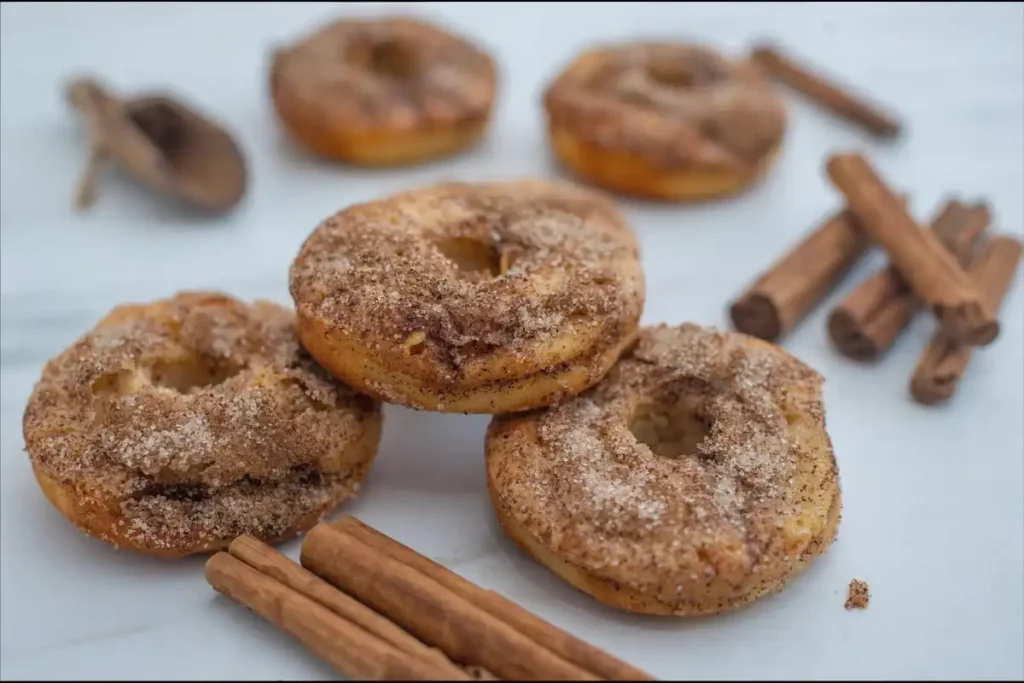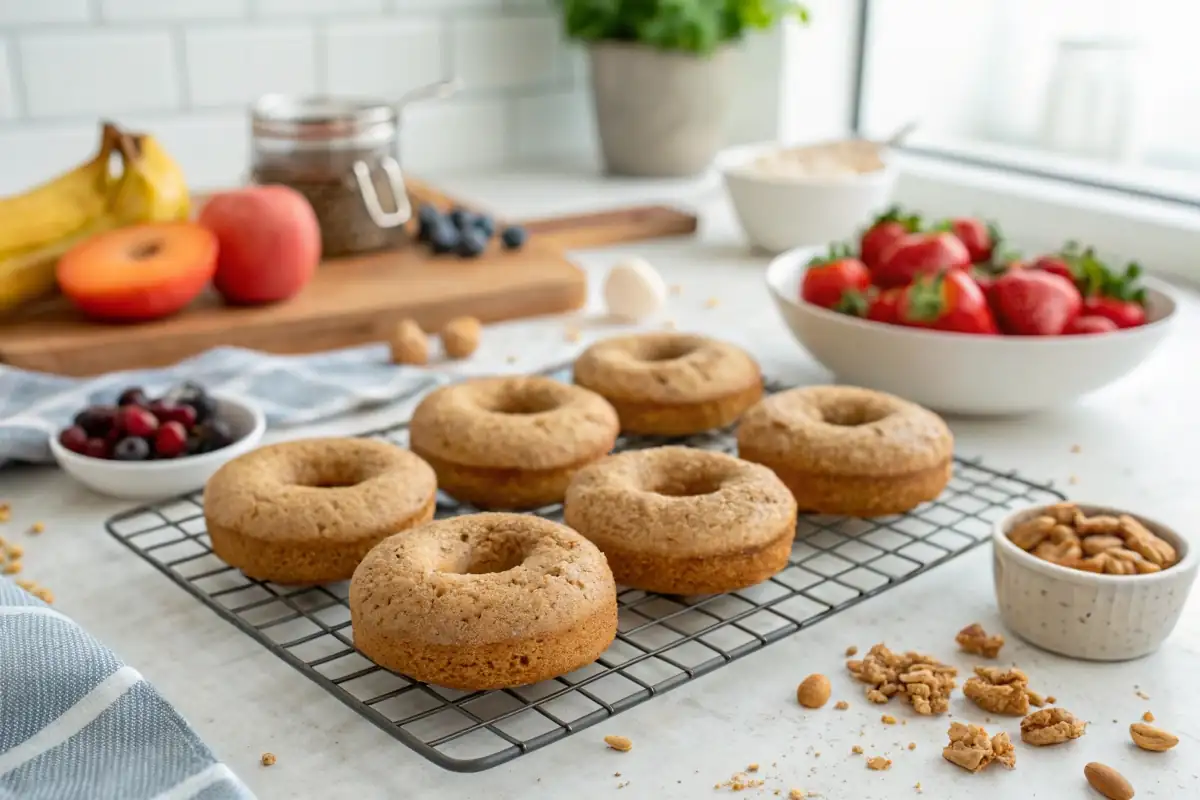Discover how to make protein donuts that satisfy your sweet cravings while boosting your nutrition. Explore key ingredients, tips, and more.
Introduction
Are you on the hunt for a guilt-free indulgence that supports your fitness goals yet still caters to your sweet tooth? Look no further than protein donuts. These treats have taken the American health-food market by storm, offering a novel way to enjoy a beloved classic with a nutritious twist. Rather than being overloaded with sugar, many protein donuts are baked using high-quality protein powders, healthier flours, and other wholesome ingredients. Therefore, they fit perfectly into a balanced diet, whether you enjoy them in the morning or save them for a post-workout snack.
In this comprehensive guide, you will learn what makes protein donuts unique, the key ingredients involved, and how to make them right in your own kitchen. In addition, you will uncover how these donuts differ from traditional ones and discover how to store, serve, and customize them. We will also tackle common baking mistakes and provide FAQ answers about their protein content. By the time you finish reading, you will feel empowered to bake your own protein donuts and easily integrate them into a healthy lifestyle.
- Introduction
- Understanding Protein Donuts and Their Rising Popularity
- Nutrition Overview — The Power of Protein in Donuts
- Key Ingredients for Crafting Protein Donuts
- Essential Equipment for Baking Protein Donuts
- Recipe Spotlight — Classic Baked Protein Donuts
- Tasty Variations and Substitutions for Protein Donuts
- Storage and Serving Suggestions
- Pairing Protein Donuts with a Balanced Meal
- Common Mistakes to Avoid When Baking Protein Donuts
- Frequently Asked Questions (FAQ)
- Conclusion
Understanding Protein Donuts and Their Rising Popularity
Protein donuts are exactly what they sound like: donuts infused with a higher protein content than traditional offerings. However, these donuts go beyond mere hype. They have become increasingly popular for several reasons, including the surge in health consciousness across the United States, the widespread interest in high-protein diets, and the desire for guilt-free indulgences. Consequently, people from all walks of life, from gym-goers to busy parents, are seeking out protein donuts as an alternative to regular fried donuts.
Why Protein Donuts Are Trending
- Health-Conscious Consumers
Americans are paying closer attention to labels, searching for products that offer better nutritional value. Protein donuts fit this narrative perfectly because they often contain fewer empty calories and more essential nutrients. - Fitness Enthusiasts’ Demand
Protein is a cornerstone for muscle development and repair. Therefore, fitness enthusiasts prioritize high-protein foods, especially those that satisfy the sweet cravings often felt after a rigorous workout. - Innovation in Baking
Improvements in baking technology and ingredient sourcing have made it easier than ever to create donuts that taste good yet offer added nutritional benefits. For instance, the availability of flavored protein powders enables bakers to experiment with various taste profiles.
Nutrition Overview — The Power of Protein in Donuts
One of the main selling points of protein donuts is their improved nutritional profile compared to standard donuts. Traditional donuts often contain refined flour, large amounts of sugar, and trans fats. In contrast, protein donuts rely on leaner ingredients to provide a more balanced macronutrient composition.
Macronutrients in Protein Donuts
- Protein
The star ingredient in these donuts, protein can come from various sources such as whey, casein, or plant-based protein powders like pea and soy. A single protein donut can offer up to 10–15 grams of protein or more, depending on the recipe. This contrasts sharply with a traditional glazed donut, which usually provides only around 2–3 grams of protein. - Carbohydrates
While protein donuts still have carbs, many recipes call for lower-glycemic alternatives (like oat flour, coconut flour, or almond flour) to keep blood sugar levels more stable. - Fats
By choosing healthy fats (for example, from nuts or coconut oil), these donuts reduce saturated fat intake. Baked protein donuts, in particular, tend to require less oil than fried varieties, further cutting down on excess fat.
Health Benefits and Examples
- Muscle Recovery
Because of their high-protein content, these donuts serve as a post-workout snack for athletes who need fast muscle repair. - Satiety and Weight Management
Protein keeps you feeling fuller for longer. Incorporating a protein donut into your meal plan could help control hunger pangs and limit sugary cravings. - Nutrient Density
Certain recipes feature nutrient-dense ingredients, such as Greek yogurt, flaxseed, and nuts, to increase vitamins and minerals. This stands in stark contrast to the mostly empty calories of typical donuts.
Key Ingredients for Crafting Protein Donuts
Creating delicious and satisfying protein donuts requires careful ingredient selection. Although specific recipes differ, the following items commonly appear in high-protein donut formulations.
Protein Powders
- Whey Protein
Whey is popular for its quick absorption and neutral flavor, making it ideal for most baked goods. - Casein Protein
Casein protein yields a slightly denser texture and slower digestion rate, which many bakers appreciate for creating moist donuts. - Plant-Based Protein
Options like pea, brown rice, or soy protein can be used to create vegan or dairy-free versions. However, slight recipe adjustments may be necessary due to differences in texture.
Flours and Binders
- Whole Wheat Flour
Provides extra fiber while still maintaining a familiar wheat-based texture. - Almond Flour
Adds a subtly sweet, nutty taste and a dose of healthy fats. - Coconut Flour
Absorbs a lot of moisture, so you typically need extra liquid or eggs to achieve the right consistency.
Sweeteners and Flavor Enhancers
- Natural Sweeteners
Honey, maple syrup, or mashed banana can offer sweetness without heavily spiking blood sugar levels. - Sugar Substitutes
Erythritol and stevia are calorie-free or low-calorie options that help reduce overall sugar content. - Flavor Boosters
Vanilla extract, cinnamon, and cocoa powder are common add-ins. They enhance taste without significantly increasing calories.

Essential Equipment for Baking Protein Donuts
Although many of the same items used for traditional baking can be used to make protein donuts, a few specialized tools can streamline the process.
Donut Pan vs. Donut Maker
- Donut Pan
Typically made of silicone or metal, donut pans allow you to bake your batter into the classic donut shape. This is often the simplest and most cost-effective method. - Electric Donut Maker
Provides a quick cooking process and uniform results, but it can be more expensive and require additional countertop space.
Helpful Kitchen Items
- Mixing Bowls
You will need at least two (one for dry ingredients, one for wet ingredients). - Measuring Cups and Spoons
Ensuring precise measurements is crucial for recipes relying on protein powders. - Spatula or Whisk
Helps with mixing to the right consistency without overworking the batter. - Cooling Rack
Allows moisture to escape from freshly baked donuts, preventing them from becoming soggy.
Recipe Spotlight — Classic Baked Protein Donuts
Below is a tried-and-true recipe for baked protein donuts that offers a great balance of taste and nutrition. This recipe is easy to adapt based on your dietary preferences or needs.

Ingredients
- 1 cup (120g) almond flour
- ⅓ cup (30g) whey protein powder (vanilla or unflavored)
- ½ cup (120ml) unsweetened almond milk
- 2 tablespoons (30g) Greek yogurt
- 1 large egg (room temperature)
- 2 tablespoons (30g) erythritol (or your preferred sweetener)
- 1 teaspoon baking powder
- 1 teaspoon vanilla extract
- ¼ teaspoon salt
- Cooking spray or a small amount of coconut oil to grease the pan
Step-by-Step Instructions
- Preheat the Oven
Preheat your oven to 350°F (175°C). Lightly grease a donut pan with cooking spray or coconut oil to prevent the batter from sticking. - Combine Dry Ingredients
In a medium-sized mixing bowl, whisk together almond flour, whey protein powder, baking powder, erythritol, and salt. This helps evenly distribute all dry components. - Blend Wet Ingredients
In another bowl, whisk the egg, almond milk, Greek yogurt, and vanilla extract until you achieve a smooth mixture. Make sure there are no lumps in the yogurt. - Mix It All Together
Gently pour the wet mixture into the dry ingredients. Stir just until combined. Avoid overmixing, as this can produce dense donuts. - Fill the Donut Pan
Transfer the batter to the greased donut pan. Fill each well about three-quarters full to allow space for the donuts to rise. - Bake
Place the donut pan on the middle rack of the oven. Bake for approximately 12–15 minutes, or until the donuts are lightly golden. To test for doneness, insert a toothpick into one of the donuts; if it comes out clean, they are ready. - Cool and Decorate
Carefully remove the donuts from the pan and set them on a cooling rack. Let them cool completely before adding any glaze or topping of your choice.
Nutritional Information (per 100g)
| Nutrient | Amount |
|---|---|
| Calories | 220 kcal |
| Protein | 15 g |
| Carbohydrates | 13 g |
| Fats | 12 g |
| Fiber | 4 g |
| Sugar | 2 g |
| Sodium | 180 mg |
Tasty Variations and Substitutions for Protein Donuts
Protein donuts are incredibly versatile, which means you can easily tailor them to your taste preferences or dietary restrictions. For example, if you prefer a chocolatey twist, add cocoa powder or chocolate-flavored protein powder.
Flavor Adaptations

- Chocolate Protein Donuts
Swap out a few tablespoons of flour for unsweetened cocoa powder, and use chocolate protein powder to boost the flavor. - Pumpkin Spice Donuts
Add pumpkin puree and a blend of cinnamon, nutmeg, and cloves. This variety is particularly enjoyable in the fall. - Cinnamon Swirl
Incorporate extra ground cinnamon and a drizzle of cinnamon-sugar swirl on top before baking.
Dietary Adjustments
- Gluten-Free
For those with gluten sensitivities, rely entirely on almond flour, coconut flour, or oat flour certified gluten-free. - Vegan Options
Use plant-based protein powder, a flax egg (1 tablespoon flaxseed meal + 3 tablespoons water), and non-dairy yogurt or applesauce.
Creative Toppings
- Drizzle of Yogurt Glaze
Mix Greek yogurt with a little sweetener and a pinch of vanilla extract. Then drizzle over cooled donuts. - Peanut Butter Glaze
Thin out peanut butter with almond milk or water for a protein-packed finish. - Fruit Preserves
Lightly spread unsweetened fruit jam for a burst of fruity flavor.
Storage and Serving Suggestions
To maintain freshness, store your protein donuts in an airtight container. However, be cautious about moisture buildup. If you notice condensation, consider placing a paper towel in the container to absorb excess moisture. In general, baked protein donuts can remain good at room temperature for up to two days, but refrigeration can extend their life to around four or five days.
When to Enjoy Protein Donuts
- Breakfast Boost
A warm protein donut pairs well with morning coffee or tea. For additional nutrition, serve it alongside fresh fruit or a glass of skim milk. - Post-Workout Snack
These donuts are especially rewarding after exercise, helping replenish energy and promote muscle recovery. - Dessert with Benefits
Enjoy them guilt-free as a healthier take on a sweet treat.
Pairing Protein Donuts with a Balanced Meal
Protein donuts work best when part of an overall balanced meal plan. For instance, you might combine them with a side of scrambled egg whites or a small bowl of fruit salad for a more comprehensive breakfast. In addition, pairing protein donuts with nutrient-dense foods such as Greek yogurt can help round out your macros.
- Pre-Workout
Opt for a donut plus a small portion of complex carbohydrates, like oatmeal or whole grain toast, to fuel your gym session. - Post-Workout
Enjoy a donut with a protein shake or a small serving of cottage cheese to amplify muscle repair. - Snacking in Moderation
Although these donuts are more nutritious, portion control remains important. Balance them with other whole foods throughout your day.
Common Mistakes to Avoid When Baking Protein Donuts
Even if you follow a recipe, a few common slip-ups can lead to less-than-ideal results. Nevertheless, knowing these pitfalls helps you steer clear of them.
- Overmixing the Batter
Overworking the batter will cause the donuts to become dense or gummy. Stir only until just combined. - Excessive Protein Powder
Doubling up on protein powder might seem like a good idea, but it can dry out the dough. Stick to tested ratios. - Ignoring Temperature
Baking at too high a temperature can lead to burnt edges but undercooked centers. - Rushing the Cooling Process
Let donuts cool fully before adding toppings. Otherwise, glazes may melt off, and textures can become soggy.
Frequently Asked Questions (FAQ)
What donut has the most protein?
High-protein donuts made with whey or casein powders typically pack the most protein. The exact amount can vary, but some donut brands or recipes can exceed 15 grams of protein per donut.
Does a doughnut have protein?
Traditional doughnuts do contain small amounts of protein (usually 2–4 grams), but protein donuts are specifically formulated to offer a much higher protein content. They incorporate protein powder and other healthful ingredients to achieve this.
What is a healthy alternative to doughnuts?
Protein donuts are an excellent alternative, as they reduce excess sugar and fat while increasing protein content. Other healthy alternatives include baked whole-wheat muffins, protein bars, and Greek yogurt parfaits topped with fruit and granola.
Conclusion
Protein donuts strike a balance between classic taste and modern nutritional demands. They can be baked at home using accessible ingredients like protein powders, whole-grain flours, and low-calorie sweeteners. Moreover, they offer a higher protein-to-carbohydrate ratio compared to traditional donuts, making them a viable post-workout snack or healthier breakfast option.
By understanding the essential ingredients, baking techniques, and potential pitfalls, you can ensure your protein donuts turn out fluffy, flavorful, and nourishing. Consequently, these donuts can add variety to your meal plan while helping you stay on track with health and fitness goals. Whether you opt for chocolate, pumpkin spice, or stick to the classic vanilla, protein donuts will keep you coming back for more.
If you are craving more fun breakfast options, you might want to check out our Protein Pumpkin Muffins Guide or our Delicious Breakfast Pizza Rolls for ideas on how to start your day off right.
Enjoy exploring all the creative ways to embrace this healthier take on a timeless favorite!

